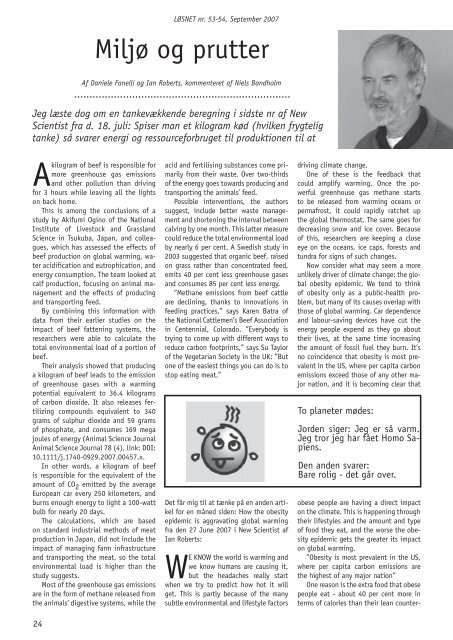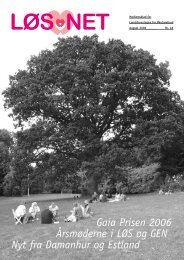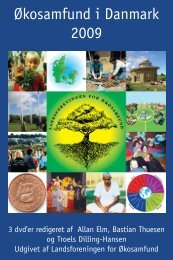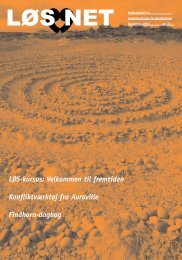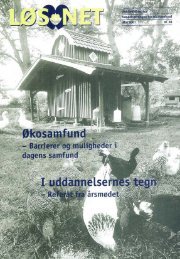You also want an ePaper? Increase the reach of your titles
YUMPU automatically turns print PDFs into web optimized ePapers that Google loves.
24<br />
LØSNET nr. 53-54, September 2007<br />
Miljø <strong>og</strong> prutter<br />
Af Daniele Fanelli <strong>og</strong> Ian Roberts, kommenteret af Niels Bandholm<br />
Jeg læste d<strong>og</strong> om en tankevækkende beregning i sidste nr af New<br />
Scientist fra d. 18. juli: Spiser man et kil<strong>og</strong>ram kød (hvilken frygtelig<br />
tanke) så svarer energi <strong>og</strong> ressourceforbruget til produktionen til at<br />
A<br />
kil<strong>og</strong>ram of beef is responsible for<br />
more greenhouse gas emissions<br />
and other pollution than driving<br />
for 3 hours while leaving all the lights<br />
on back home.<br />
This is among the conclusions of a<br />
study by Akifumi Ogino of the National<br />
Institute of Livestock and Grassland<br />
Science in Tsukuba, Japan, and colleagues,<br />
which has assessed the effects of<br />
beef production on global warming, water<br />
acidification and eutrophication, and<br />
energy consumption. The team looked at<br />
calf production, focusing on animal management<br />
and the effects of producing<br />
and transporting feed.<br />
By combining this information with<br />
data from their earlier studies on the<br />
impact of beef fattening systems, the<br />
researchers were able to calculate the<br />
total environmental load of a portion of<br />
beef.<br />
Their analysis showed that producing<br />
a kil<strong>og</strong>ram of beef leads to the emission<br />
of greenhouse gases with a warming<br />
potential equivalent to 36.4 kil<strong>og</strong>rams<br />
of carbon dioxide. It also releases fertilizing<br />
compounds equivalent to 340<br />
grams of sulphur dioxide and 59 grams<br />
of phosphate, and consumes 169 mega<br />
joules of energy (Animal Science Journal<br />
Animal Science Journal 78 (4), link: DOI:<br />
10.1111/j.1740-0929.2007.00457.x.<br />
In other words, a kil<strong>og</strong>ram of beef<br />
is responsible for the equivalent of the<br />
amount of CO2 emitted by the average<br />
European car every 250 kilometers, and<br />
burns enough energy to light a 100-watt<br />
bulb for nearly 20 days.<br />
The calculations, which are based<br />
on standard industrial methods of meat<br />
production in Japan, did not include the<br />
impact of managing farm infrastructure<br />
and transporting the meat, so the total<br />
environmental load is higher than the<br />
study suggests.<br />
Most of the greenhouse gas emissions<br />
are in the form of methane released from<br />
the animals’ digestive systems, while the<br />
acid and fertilising substances come primarily<br />
from their waste. Over two-thirds<br />
of the energy goes towards producing and<br />
transporting the animals’ feed.<br />
Possible interventions, the authors<br />
suggest, include better waste management<br />
and shortening the interval between<br />
calving by one month. This latter measure<br />
could reduce the total environmental load<br />
by nearly 6 per cent. A Swedish study in<br />
2003 suggested that organic beef, raised<br />
on grass rather than concentrated feed,<br />
emits 40 per cent less greenhouse gases<br />
and consumes 85 per cent less energy.<br />
”Methane emissions from beef cattle<br />
are declining, thanks to innovations in<br />
feeding practices,” says Karen Batra of<br />
the National Cattlemen’s Beef Association<br />
in Centennial, Colorado. ”Everybody is<br />
trying to come up with different ways to<br />
reduce carbon footprints,” says Su Taylor<br />
of the Vegetarian Society in the UK: ”But<br />
one of the easiest things you can do is to<br />
stop eating meat.”<br />
Det får mig til at tænke på en anden artikel<br />
for en måned siden: How the obesity<br />
epidemic is aggravating global warming<br />
fra den 27 June 2007 i New Scientist af<br />
Ian Roberts:<br />
WE KNOW the world is warming and<br />
we know humans are causing it,<br />
but the headaches really start<br />
when we try to predict how hot it will<br />
get. This is partly because of the many<br />
subtle environmental and lifestyle factors<br />
driving climate change.<br />
One of these is the feedback that<br />
could amplify warming. Once the powerful<br />
greenhouse gas methane starts<br />
to be released from warming oceans or<br />
permafrost, it could rapidly ratchet up<br />
the global thermostat. The same goes for<br />
decreasing snow and ice cover. Because<br />
of this, researchers are keeping a close<br />
eye on the oceans, ice caps, forests and<br />
tundra for signs of such changes.<br />
Now consider what may seem a more<br />
unlikely driver of climate change: the global<br />
obesity epidemic. We tend to think<br />
of obesity only as a public-health problem,<br />
but many of its causes overlap with<br />
those of global warming. Car dependence<br />
and labour-saving devices have cut the<br />
energy people expend as they go about<br />
their lives, at the same time increasing<br />
the amount of fossil fuel they burn. It’s<br />
no coincidence that obesity is most prevalent<br />
in the US, where per capita carbon<br />
emissions exceed those of any other major<br />
nation, and it is becoming clear that<br />
To planeter mødes:<br />
Jorden siger: Jeg er så varm.<br />
Jeg tror jeg har fået Homo Sapiens.<br />
Den anden svarer:<br />
Bare rolig - det går over.<br />
obese people are having a direct impact<br />
on the climate. This is happening through<br />
their lifestyles and the amount and type<br />
of food they eat, and the worse the obesity<br />
epidemic gets the greater its impact<br />
on global warming.<br />
”Obesity is most prevalent in the US,<br />
where per capita carbon emissions are<br />
the highest of any major nation”<br />
One reason is the extra food that obese<br />
people eat - about 40 per cent more in<br />
terms of calories than their lean counter-


